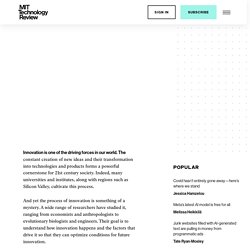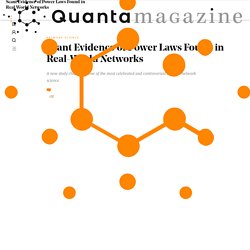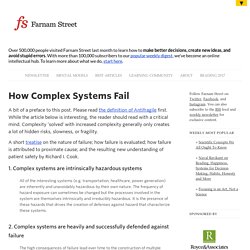

Mathematics Shows How to Ensure Evolution. A Classical Math Problem Gets Pulled Into the Modern World. Mathematical Model Reveals the Patterns of How Innovations Arise. Innovation is one of the driving forces in our world.

The constant creation of new ideas and their transformation into technologies and products forms a powerful cornerstone for 21st century society. Indeed, many universities and institutes, along with regions such as Silicon Valley, cultivate this process. And yet the process of innovation is something of a mystery. A wide range of researchers have studied it, ranging from economists and anthropologists to evolutionary biologists and engineers. Their goal is to understand how innovation happens and the factors that drive it so that they can optimize conditions for future innovation. This approach has had limited success, however. 7 Areas of Game Theory That Can Help You Understand the World. In his conversation with Dave Rubin and his brother Eric, Bret Weinstein says that seeing the world through a game theoretic lens gives you a more fundamental understanding of the world.

When asked later about the parts of game theory he’d recommend learning, he listed seven. Scant Evidence of Power Laws Found in Real-World Networks. In a power law distribution, there is no characteristic scale (thus the name “scale-free”).

A power law has no peak — it simply decreases for higher degrees, but relatively slowly, and if you zoom in on different sections of its graph, they look self-similar. As a result, while most nodes still have low degree, hubs with an enormous number of links do appear in small quantities, at every scale. The scale-free paradigm in networks emerged at a historical moment when power laws had taken on an outsize role in statistical physics.
In the 1960s and 1970s they had played a key part in universal laws that underlie phase transitions in a wide range of physical systems, a finding that earned Kenneth Wilson the 1982 Nobel Prize in physics. THE ADJACENT POSSIBLE. (STUART KAUFFMAN): In his famous book, What is Life?

, Erwin Schrödinger asks, "What is the source of the order in biology? " He arrives at the idea that it depends upon quantum mechanics and a microcode carried in some sort of aperiodic crystal—which turned out to be DNA and RNA—so he is brilliantly right. But if you ask if he got to the essence of what makes something alive, it's clear that he didn't. Although today we know bits and pieces about the machinery of cells, we don't know what makes them living things. However, it is possible that I've stumbled upon a definition of what it means for something to be alive. The evolution of design to amplify flow. If we want to understand the importance of flows in our world, the new book Design in Nature released this week by Adrian Bejan and J.

Peder Zane is a must-read. It will literally change how you view the world – everything from snowflakes to volcanos. Beyond the Bell Curve, a New Universal Law. Imagine an archipelago where each island hosts a single tortoise species and all the islands are connected — say by rafts of flotsam. As the tortoises interact by dipping into one another’s food supplies, their populations fluctuate. In 1972, the biologist Robert May devised a simple mathematical model that worked much like the archipelago. He wanted to figure out whether a complex ecosystem can ever be stable or whether interactions between species inevitably lead some to wipe out others. By indexing chance interactions between species as random numbers in a matrix, he calculated the critical “interaction strength” — a measure of the number of flotsam rafts, for example — needed to destabilize the ecosystem.
Below this critical point, all species maintained steady populations. Geoffrey West: The surprising math of cities and corporations. Too complex to exist - The Boston Globe. ON . 10, 1996, a single power line in western Oregon brushed a tree and shorted out, triggering a massive cascade of power outages that spread across the western United States. Frantic engineers watched helplessly as the crisis unfolded, leaving nearly 10 million people without electricity. Even after power was restored, they were unable to explain adequately why it had happened, or how they could prevent a similar cascade from happening again - which it did, in the Northeast on Aug. 14, 2003. Over the past year we have experienced something similar in the financial system: a dramatic and unpredictable cascade of events that has produced the economic equivalent of a global blackout.
As governments struggle to fix the crisis, experts have weighed in on the causes of the meltdown, from excess leverage, to lax oversight, to the way executives are paid. How Claude Shannon Rebooted Information. With his marriage to Norma Levor over, Claude Shannon was a bachelor again, with no attachments, a small Greenwich Village apartment, and a demanding job.

His evenings were mostly his own, and if there’s a moment in Shannon’s life when he was at his most freewheeling, this was it. He kept odd hours, played music too loud, and relished the New York jazz scene. He went out late for raucous dinners and dropped by the chess clubs in Washington Square Park. He rode the A train up to Harlem to dance the jitterbug and take in shows at the Apollo. He went swimming at a pool in the Village and played tennis at the courts along the Hudson River’s edge. His home, on the third floor of 51 West Eleventh Street, was a small New York studio.
Complexity Explorer. Lagrangian coherent structures: The skeleton of water. Thomas Peacock THE connection between an 18th-century savant called Joseph-Louis Lagrange and the problem of landing safely at Hong Kong International Airport may not, at first, be obvious.

But there is one. Hong Kong airport is notorious for rocky and sometimes aborted landings caused by the disturbed air flow from nearby mountains. Though laser technology is deployed alongside its runways to monitor changes in wind speed and thus forewarn pilots, that is often not enough. A Cascade of Sand: Complex Systems in a Complex Time. We live in a world filled with rapid change: governments topple, people rise and fall, and technology has created a connectedness the world has never experienced before.

Joshua Cooper Ramo believes this environment has created an “‘avalanche of ceaseless change.” How Complex Systems Fail. A bit of a preface to this post.

Please read the definition of Antifragile first. While the article below is interesting, the reader should read with a critical mind. Complexity ‘solved' with increased complexity generally only creates a lot of hidden risks, slowness, or fragility. A short treatise on the nature of failure; how failure is evaluated; how failure is attributed to proximate cause; and the resulting new understanding of patient safety by Richard I. The Computational Foundation of Life. What’s the difference between physics and biology?

Take a golf ball and a cannonball and drop them off the Tower of Pisa. The laws of physics allow you to predict their trajectories pretty much as accurately as you could wish for. Now do the same experiment again, but replace the cannonball with a pigeon. Biological systems don’t defy physical laws, of course — but neither do they seem to be predicted by them. How to Build a Probability Microscope - Issue 44: Luck. If the rumors are true, 20th Century Fox will release a remake of the 1966 science-fiction film Fantastic Voyage in the next year or two. The conceit behind the film is that its protagonists are shrunk down and injected into the human body, through which they travel in a microscopic submarine.
At that size, a swirl of blood turns into dangerous turbulence. White blood cells can engulf their ship. Emergence. If we were pressed to give a definition of emergence, we could say that a property is emergent if it is a novel property of a system or an entity that arises when that system or entity has reached a certain level of complexity and that, even though it exists only insofar as the system or entity exists, it is distinct from the properties of the parts of the system from which it emerges. However, as will become apparent, things are not so simple because “emergence” is a term used in different ways both in science and in philosophy, and how it is to be defined is a substantive question in itself. The term “emergence” comes from the Latin verb emergo which means to arise, to rise up, to come up or to come forth.
The term was coined by G. H. Lewes in Problems of Life and Mind (1875) who drew the distinction between emergent and resultant effects. Table of Contents. The fugue of life: why complexity matters in neuroscience. People like simplicity. Each decade, corporate logos grow progressively minimalistic, pop songs use ever simpler melodies, and visual arts embrace simpler compositions as Monet gives way to Picasso, and Picasso to Rothko.
A Unified Theory Of Randomness. Standard geometric objects can be described by simple rules — every straight line, for example, is just y = ax + b — and they stand in neat relation to each other: Connect two points to make a line, connect four line segments to make a square, connect six squares to make a cube. How Sea Otters and Starfish Balance Their Ecosystems. Even in 1963, one had to go pretty far to find places in the United States that were not disturbed by people. The Four Laws of Ecology: What Ecology Really Means. Ecology is the study of relationships and processes linking living things to the physical and chemical environment. Chaos Theory in Ecology Predicts Future Populations.
Sometimes ecological data just don’t make sense. The sockeye salmon that spawn in British Columbia’s Fraser River offer a prime example. ‘Critical Slowing’ Warns of Looming Disasters. Underground ant city in Brazil that 'rivals the Great Wall of China' with a labyrinth of highways. By Julian Gavaghan Updated: 16:51 GMT, 2 February 2012. What Do Ants Know That We Don't? Ever notice how ant colonies so successfully explore and exploit resources in the world … to find food at 4th of July picnics, for example? Ants Swarm Like Brains Think - Issue 12: Feedback. Computer Vision Reveals The Remarkable Secret of Flocking. Fairy Circle Mystery Solved By Computational Modelling. How Wolves Change Rivers.
In the eye of a chicken, a new state of matter comes into view. Fractal Geometry. Complex Systems. Complexity Timeline. Chaos & Complexity Pdf Library > GaianXaos. Complexity Pages, tutorial, booklist, articles etc. Complexity & Chaos - Part 1 (Introduction) 21. Chaos and Reductionism. Complexity Explorer. Iecps Institute of Studies of Complexity and Systems Thinking. Think Complexity. ChaosBook.org. Eric Berlow: How complexity leads to simplicity.
What is Emergent Thinking? TO UNDERSTAND IS TO PERCEIVE PATTERNS. Why does modularity evolve? The evolutionary origins of modularity. How Things Handle Disorder. On Early Warning Signs. How Complex Networks Explode with Growth. Using Chaos Theory to Predict and Prevent Catastrophic 'Dragon King' Events - Wired Science. Numbers Warn Of Looming Collapses. Butterfly - The Secret Life of Chaos - BBC 4 Preview. Sensitivity to Initial Conditions (Butterfly Effect) Demonstrated on a Lorenz Attractor. A Simple Algorithm for a Complex Shell Game. Conway's Game of Life. NetLogo Home Page. The Implicate Order. Holism. Stephen Wolfram: Computing a theory of all knowledge.